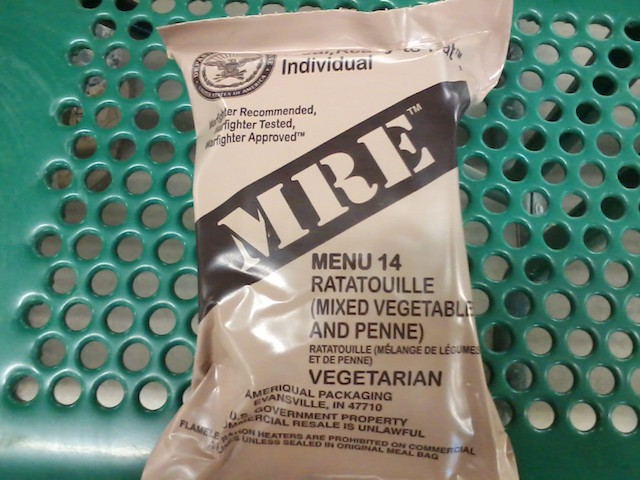
An MRE I'd never have been able to predict when I was a PFC
*Cooking With MRE Heaters*
By: gvi
24 April 2014
Revised 30 May 2020
Note: Photograph order was scrambled during original formatting of this article. This revision places the photographs in the correct order; the text is unchanged.
It's the rare (and rarefied) Soldier who is not only currently serving but still remembers C-rations. I'd only ever had them once in Basic Training, and it wouldn't surprise me to learn that they were retrieved from an on-post museum just to remind us raw recruits how good we had it. They were on the way out well before Soldiers of my vintage ever raised their right hands at the recruiting station for the first time.
The field rations which replaced them, MREs, started off being not much of an improvement over the old Cs. We could keep them down, after a fashion, but the presence of tiny little bottles of Tabasco sauce in the second "iteration" of the meals ought to say something about how well-regarded they were prior to being doctored up. I don't like Tabasco, so on Active Duty I always kept a small bottle of soy sauce and a shaker of Lowry's in my buttpack.
Nowadays they are much improved, so much so that Reservists who are used to them actually look forward to eating them - I can no longer speak for Active Duty Soldiers. The people who make them, I gather, survey Soldiers often to learn what we like and what we don't like, as well as what we would like to see in future meals. They rotate the menus every two years, inserting new items and removing unpopular ones...

An MRE I'd never have been able to predict when I was a PFC
As good as they are, they still take an open mind and a sort of "willing suspension of disbelief."
I will say in their defense, that my daughter enjoys eating them, though perhaps this is more out of a sense of adventure and carefree abandon, to say nothing of the unarguable comedy potential inherent in a teenager's interpretation of what the Department of Defense considers "fit for human consumption." Emily shares her dad's off-kilter sense of humor.
Much research and thought goes into making them palatable and a complete meal. For many years now each meal includes a "Flameless Ration Heater" and a "Hot Beverage Bag." The Flameless Ration Heater is a sort of plastic envelope which holds a porous envelope inside it. This latter contains a chemical compound that gets hot when it comes in contact with water. The idea is that the Soldier decides which part of the meal he wants heated up - MREs come with only one heater-upper per meal, though the Soldier can save them and there are always plenty left unused in the "share box" (the time-honored tradition of an opened MRE carton into which each Soldier puts those things he doesn't like, from which everyone can pick over and snack on at will and leisure) - puts the item in the heater-upper envelope, pours a tiny bit of water in, closes it up according to the instructions printed on the heater-upper, then waits. Ten minutes or so later, the thing is quite hot and ready to be eaten.
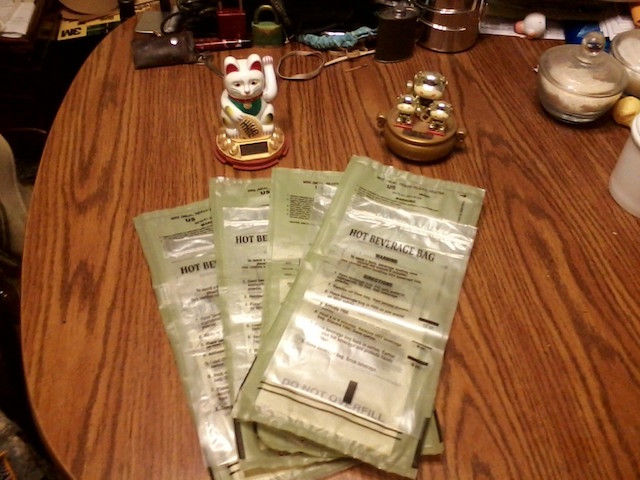
Chinese good-luck cat and cows not included
One of the quaint little idiosyncrasies of the heater-upper is an illustration on the printed instructions, showing how the whole assembly ought to look while it's "cooking:"
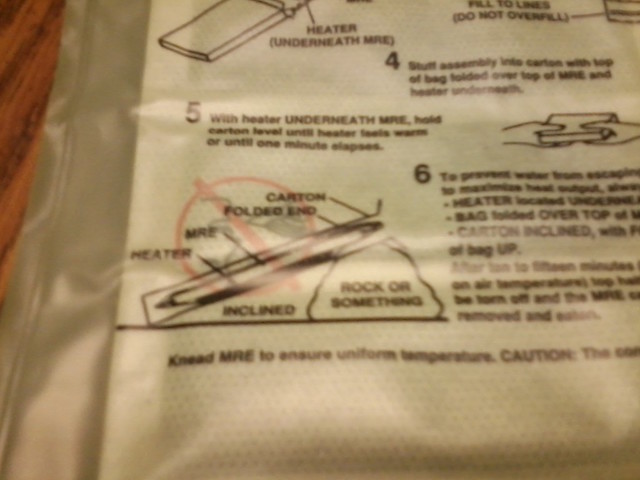
"Rock or something" is a level of informality in military instructions which is as uncommon as it is charming. It's been on the things as long as they've been around and no one in a position of authority has ever demanded it be replaced with something rhetorically "drier."
The things are meant to be used to heat either "entrees" in their heavy-foil retort pouches (similar to those which small servings of tuna and other foods now come in - and guess where they got THAT idea), or beverages like coffee, tea and cocoa in the "Hot Beverage Bag." Being a Soldier "of a certain age," I've seldom bothered using the heater-uppers - I started off eating the things unheated, and that's how I tend to continue eating them. So I've accumulated a rather large quantity of these heater-uppers and bags.
You can find these things in bulk from time-to-time on the websites of online surplus vendors. Or you can ask a friend in the military to collect the ones he doesn't go through and mail them to you.
Chez GVI is no one's idea of "palatial." Space is a premium and even these little bags, which take up no more space than an article of junk mail, must earn their place. So the thought occurred to me that we might be able to "cook" certain foods we normally eat in them, and naturally I intended to put the results up as an article because a) it might come in handy to the Rubie who wants to cook something up with one of these things, and b) the unarguable comedy potential inherent in a Rubie's interpretation of what the Department of Defense considers "cooking."
The idea is that at times when space is at an absolute premium, or where stoves and their fuel can't be carried, what can we do to prepare something worth eating in the smallest possible space with the least possible weight? My personal example was my own daughter. She has little space in her book bag for "Just in Case" items and the presence of, for example, an Esbit or Trangia stove and matches under normal circumstances would raise more questions than they answered.
Cowardly indeed is the Rubie unwilling to put his innards through bizarre trials in the name of discovery and learning, and I bow to no one in my sense of culinary adventure. So it is that we have the body of this article, which is a test of the MRE heater-upper's ability to prepare simple staples.
I started out with four each of the heater-uppers and the Hot Beverage Bags.
With these I will attempt to render fit for consumption the following staples:
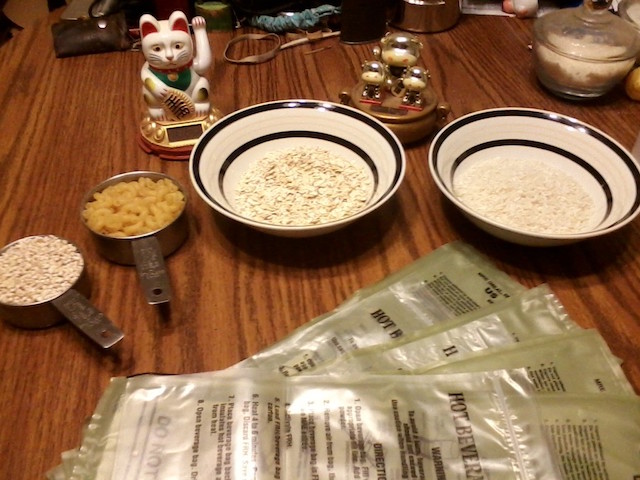
Chinese good-luck cat and dancing cows STILL not included
These things are simple enough and sufficiently hearty that one can keep body and soul together with them. They also form the basis for simple meals, with the addition of meats, sauces and such "doctoring up" as the adventurous field-chef can devise. I will go through what I did for each foodstuff and report the results, whether good, bad or indifferent.
The first thing I tried was the Quick Oats. I figured these had the greatest chance for success, since they only need to be cooked for a minute. Quick oats cook to the proportion of one part of oats by volume to two parts water. I therefore used four ounces of oats
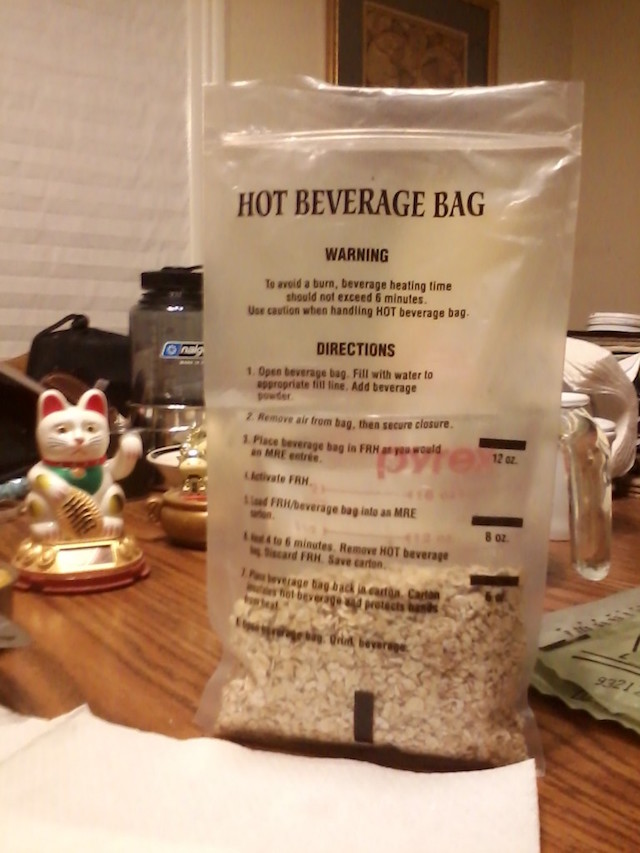
To 8 ounces of water
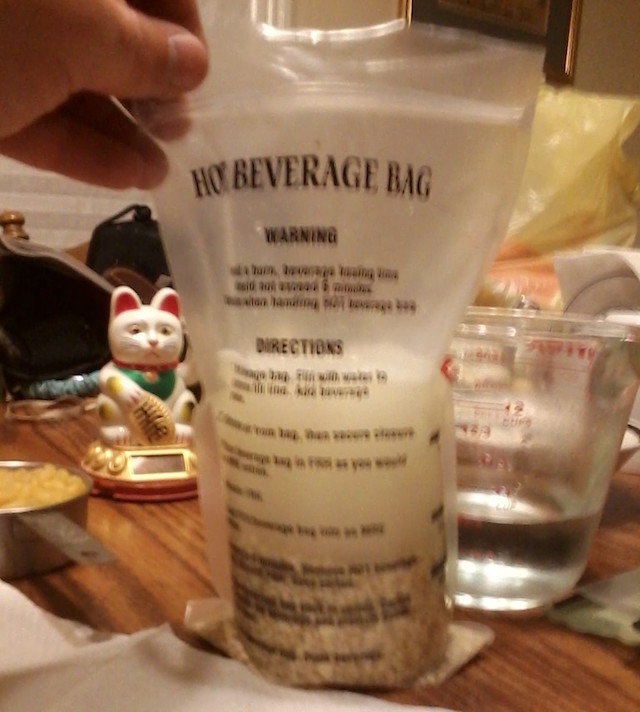
The photo doesn't do justice to this mixture - it really looks quite appallingly disgusting
Into the heater-upper they went...
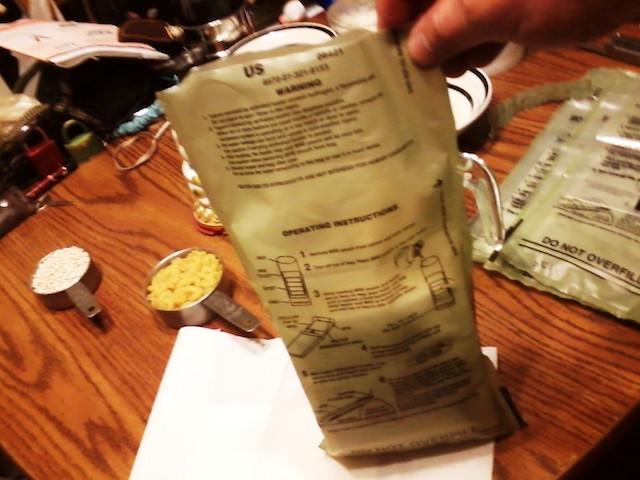
And after water, the whole thing got set out on the porch to heat.
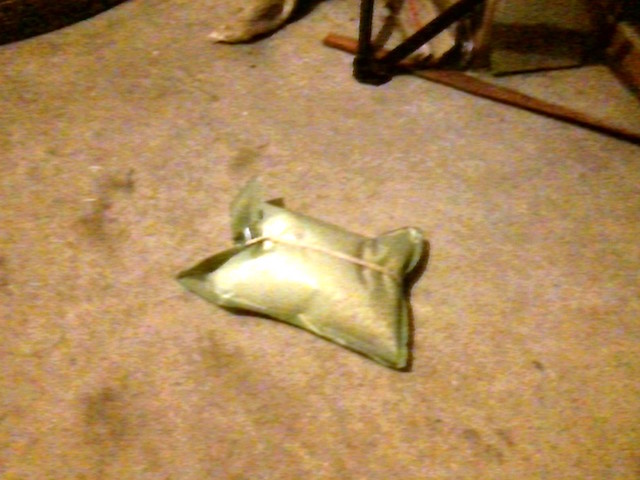
It only took about 20 seconds for the heating element to get nearly too hot to touch
I set it out on the porch because of a fact I neglected to point out earlier, which is that the heater-upper gives off vapors which are extremely disagreeable. They'd make good smelling salts.
After about ten minutes or so I brought the bag in...
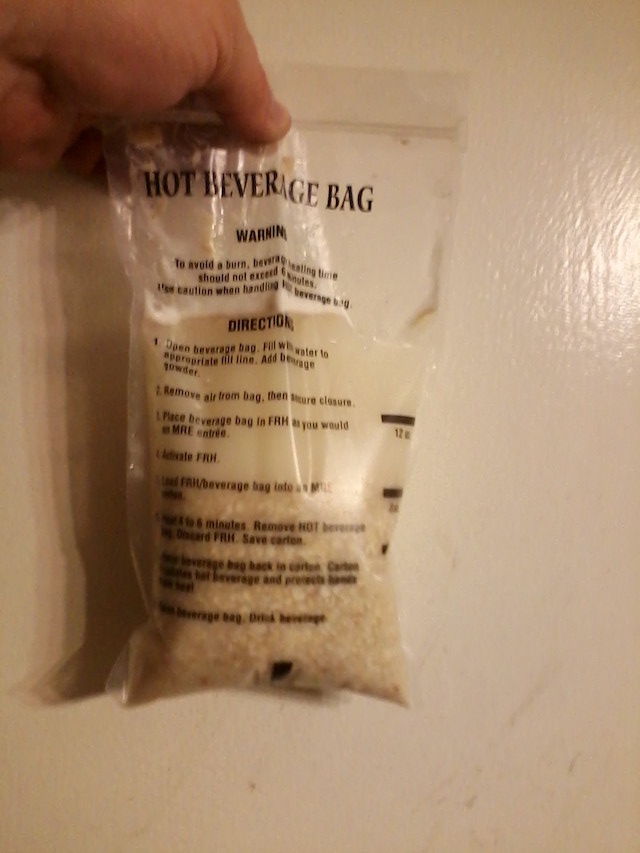
...and discovered that I'd used FAR too much water for cooking oats in such a manner.
What I ended up with was four ounces of soft oatmeal, swimming in a suspension of oatmeal "broth" that bore an unsettling resemblance to the stuff they pump into the feeding tubes of stroke patients who cannot eat solid food. I tasted a spoonful of the oats thus cooked and while they had the taste of cooked oats, the consistency was unappealing.
The good news is that my dog Sam loved it. It went in his bowl and he lapped it up gratefully.
Lesson Learned: Use less water - a 1:1 ratio is probably best.
Next up are the macaroni noodles. Noodles need to be drained normally so there's no incentive to try to get the proportions of water correct. And at any rate, the starchy water can be used to reconstitute a can of soup or a freeze-dried meat (if I had any of that sort of thing lying around, which I don't).
Posting additional photos would be pointless, since they would look the same as the previous ones. The results of the macaroni were as follows: They "cooked," in that they weren't crunchy. But they had a bizarre texture to them and weren't all that good. The vapor from the heater also somehow tainted the taste of the noodles, or perhaps I inhaled a bit of it when I took the noodles from the pouch.
Thank goodness for my dog Sam. These too he finished without complaint.
Given the results thus far, the rice and barley were dispensed with entirely as being a pointless waste.
But let's not throw out the baby with the MRE water. The method will cook quick oats, provided I get the proportions down. Likewise liquid stuffs such as canned soup - split a can of Campbell's broth-based soup between two heater-uppers, fill the remainder with water and use normally. Powdered soups likewise can be similarly done up without fear - Maggi puts out several good ones, especially those found in "import" grocery stores catering to European expatriates (there are dozens of such stores in Chicago and plenty of online vendors). They are of such size as will work well with the Hot Beverage Bag. Instant rice will work well when added to soups before heating, as would the little pouches of pre-cooked bacon bits.
But leave staple starches to the camp stove.
In the short-term, however, the jury has returned with its verdict:
Ramen...
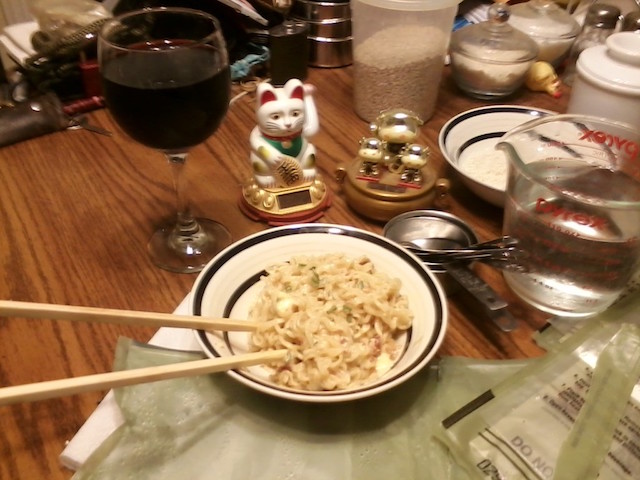
...it's what's for dinner!
www.alpharubicon.com
All materials at this site not otherwise credited are Copyright © 1996 - 2020 Trip Williams. All rights reserved. May be reproduced for personal use only. Use of any material contained herein is subject to stated terms or written permission.